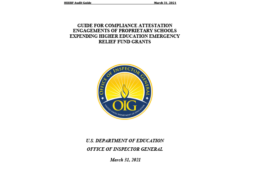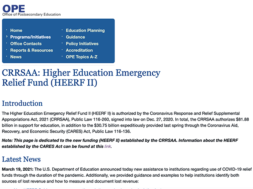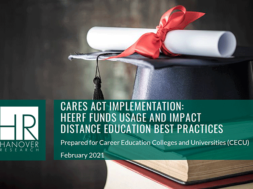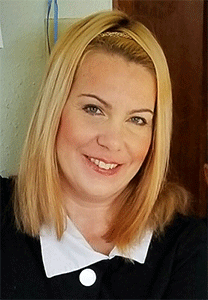
Accounting Handles Institutional Portions of the CARES Act
By Cindy R. Chamberlin, Gurnick Academy of Medical Arts, LLC, SEO and Content Specialist
Introduction
As the Coronavirus pandemic intensified, Gurnick Academy of Medical Arts’ administration took note and began moving on ground didactics to online delivery modalities early. From March 16–29, 2020, all Gurnick brick-and-mortar offices and classrooms on six campuses (except clinicals and laboratories) transitioned. Midway into the migration, on March 19, 2020, the Governor of California issued a stay-at-home order to all residents. By March 27, 2020, relief legislation, aka the Coronavirus Aid Relief and Economic Security Act (CARES Act), was enacted. Under the Office of Postsecondary Education, the law enabled the U.S. Department of Education an allotment of $14 billion to colleges as the Higher Education Emergency Relief Fund (HEERF)1.
As HEERF unfolded, Gurnick Academy of Medical Arts’ Accounting department went into high gear.
HEERF manifested in two ways, a) student portions; and b) institutional allocations. HEERF institutional monies allocated for a) costs associated with making remote learning readily accessible; b) payments for academic infrastructure upgrades; and c) wages primarily for staff, faculty, and employee retention. As a provider of allied health, nursing, and medical imaging programs, Gurnick Academy of Medical Arts applied for the maximum relief HEERF provided, which tallied upwards of 1.8 million dollars for students and another 1.8 million to the institution. Approximately two minutes after this legislation passed, Gurnick’s Accounting department staff of four went to work.
The Migration Went into Full Movement – Costs Associated with Making Remote Learning Models Readily Accessible
Shelter-in-place necessitated Gurnick Academy of Medical Arts to complete their virtual academic transition to online venues faster and more comprehensively. The Accounting department had to be in lockstep with all programs and departments to make this happen. Adaptive online learning models went from a semi-transition to a full-out movement. However, clinicals primarily still operated physically as essential services. In some instances, Gurnick Academy of Medical Arts students filled roles at clinics when senior medical personnel walked off sites in the wake of COVID fears. Other times students replaced mature medical personnel when rotated in and out of service due to COVID exposure. On April 17, the San Mateo County Health Department2 reached out to the school’s San Mateo campus director, Fred Faridian, requesting critically needed student volunteers3 to replace health-department staff. Surprisingly, events like these created new purchasing and accounting tasks.
“My responsibility was the institutional portion,” said Stephanie Nguyen Vargas, Gurnick Academy of Medical Arts’ Corporate Office manager. “I took our grant and worked with program directors. As they calculated what they needed, I ordered,” Vargas explained how COVID changed institutional buying. For instance, pre-COVID, students were given PPE at sites, but now clinical sites were out, especially of N95 masks.
“Out! Out! Out!” said Vargas. “No website. No Amazon. Nothing! To be accepted, students had to acquire PPE. All vendors were back ordered. If you didn’t have the inside scoop with someone, you couldn’t get any PPE. One Gurnick Academy program director contacted a dental office who was getting PPE from back East – Pennsylvania or New Jersey. They reached the vendor who had contacts and suppliers overseas. I got lucky! The person was a small-business owner, and we are now his number one buyer. He can fill all of our orders because we buy in bulk and [big surprise] his company is growing. Even today, it is still hard to get proper PPE.”
For other institutional purchases, Vargas said, “We had to shift gears. Everyone partnered and collaborated. C-level [corporate], administrators, program directors. Accounting in tandem formed a plan – it took a combination of all departments. We had to reach out to vendors and see what types of simulation products they had. Program directors researched products, and then we made purchases. Everyone moved very quickly.”
Accounting facilitated purchases of seemingly “goes-without-saying,” or “no-frill” items such as memberships to educational platforms, personnel laptops. These were small things such as a need for additional janitorial services. “All campuses needed extra cleaning supplies and PPE,” said an Accounting staff personnel. Didactic instructors effectively published asynchronous lectures on learning management systems, these needed receipting.
Teachers deployed curricula via a hybrid of modalities, including remote, integrated simulation, and TeleSimulation.
Adaptive learning incorporated a wide range of technologies and techniques that adjusted learning experiences to meet the participants’ needs.4* (Telesimulation offers simulation education to learners at off-site locations as in the field of medical education.)5** These services required purchasing accounts, contracts, and vendor installation accounts-receivable services. Platforms, allowing students and staff to interact with one another over coursework in realistic online environments, required financial record upkeep by the Accounting staff. Reading much like a futuristic screenplay, while remaining strangely “old-school,” education continued unabated, all under accounting professionals’ quiet, ongoing work.
Accounting Staff – Essential Heroes
On the ground, Accounting staff worked as fast as possible in award distribution processing checks, posting instructions, and mailing these out in a fervor of five business days or less to more than 1,600 students. Issuing, mailing, issuing, then mailing – then repeating the process throughout the tri-phases of distribution. Accounting staff found pandemic phases came in seemingly random sequences. One Accounting person said it seemed like the stages blended.
“Some students needed checks in stages. For example, phase one and two together, or one alone, or just two, two and three, or just three – checks cashed at differing times. Therefore, students had to be contacted and asked to cash their checks as soon as possible so that they could clear our system,” said an Accounting person.
Additionally, there was the processing of institutional upgrades, campus purchase requests, ordering from vendors, figuring contract installations, and more as facilitated by the Accounting staff. “All Gurnick Academy campuses received high-fidelity manikins,” said an Accounting staff personnel, citing this was significant as even one top-end manikin can cost upwards of $60,000, with the least expensive basing at $750. Manikin-based simulations feature high-fidelity simulators with breath sounds, heart tones, and even palpable pulses. They may also have monitors that display EKG, pulse oximeter, blood pressure, arterial waveforms, pulmonary artery waveforms, anesthetic gases, etc.6 The work of the Accounting staff brought these new models onto campuses fast and accurately.
“We had outdated manikins; now we have newly updated products, ones that are all intact,” said Joe Kheuasida, Concord campus director. “Additionally, our campus acquired lots of PPE equipment.”
Silver Lining – Purchasing Items of Academic Infrastructure
“We took advantage of these programs in a good way,” said one staff member. The “silver-lining” of COVID and CARES Act funding was that it significantly broadened Gurnick Academy’s ability to do simulation and enabled the school to invest in educational infrastructure upgrades while increasing overall capacities. Additionally, Accounting professionals facilitated Gurnick Academy’s Radiologic Technology (RT) and Magnetic Resonance Imaging (MRI) departments purchasing sophisticated MRI simulations. This provided the ability to simulate MRI unit operations on laptops. Additionally, Accounting staff aided most campuses in small investments like virtual touchless thermometers, which often remained unnoticed but were vital.
While some purchases were different at each campus, San Mateo invested in whiteboards, SimLab Oculus systems (enabling instructors to capture or access a library of 3D recordings of demonstrations so students may follow along).
Accounting helped facilitate purchases for GoPro point-of-view cameras and simulators for proctoring and entrance exams. GoPro cameras are compact, lightweight, and can capture still photos or videos in high definition through wide-angle lenses configured to work automatically with minimal intervention or remotely.7
“One thing that came from HEERF funding was it provided schools of higher learning the opportunity to change into this new environment,” said Burke Malin, Gurnick Academy of Medical Arts’ Chief Operating Officer. “Further, it was highly recommended campuses adapt and prepare in the event of a recurrence.” Gurnick Academy of Medical Arts’ infrastructure stands ready in part to their Accounting staff should another pandemic occur.
Rules of Engagement—Staff, Faculty, and Employee Retention
A subsidiary of the CARES Act was the Education Stabilization Fund (ESF)8, including a proviso that mandated institutions retain employees throughout the pandemic. “Not one person was laid off from an employee perspective,” said the administration. Gurnick Academy of Medical Arts’ even hired new staff members during the most heightened part of the pandemic and commenced new construction. Gurnick Academy of Medical Arts’ Fresno campus began a new building for a simulation lab. “One of the rules of engagement was no employee was to be laid off, and no one was to suffer pay cuts,” said Malin. Institutional funding came with a payroll protection program through the small business administration, which allowed monies as institutions kept employees working. “We were uncertain, but we had that available,” he said.
Still Processing HEERF
According to the Accounting department, while award phases may technically be “over,” the real paperwork is just beginning. Accounting department staff are now initiating the paperwork for CARES Act and HEERF monies, generating reports, reconciling ledgers, and providing copious statistical data. Institutional recipients must provide accurate detailing and categories for all award monies. They are now answering questions such as, “What demographic received the most funding? Which students completed which coursework during the funding period and were graduated? How many students did you retain using online didactics? Which programs received what equipment? What departments benefitted from grant funds? Is the student full-time or part-time? What is his/her length of enrollment? How many Pell grant recipients benefitted?” etc.
Conclusion
An Accounting staff person said, “The most important thing is that the school didn’t shut down,” commenting that many schools are currently closing their doors. “I am grateful our school had money to invest in online education. Many other schools didn’t have money to invest in students as we did.”
“It’s complicated to maintain schools of higher education during natural disasters,” said another staff person. “A lot of time and money was invested in the process so our students could sustain and thrive. I am thrilled that we were able to do that.”
“Shelter in place required administration work with accrediting bodies and programmatic accreditors to find creative ways to have meaningful simulation when students couldn’t come to school,” said Malin.
Quietly going about their work, Accounting staff are tirelessly cataloging per governmental records, indexing, and cross-referencing data collection without fanfare. With strokes of the pen and quiet tapping of adding machines, Accounting department staff are doing some of the real work of COVID—quietly and without complaint.
Should the pandemic linger, come back with more significant strains, or cease, “We had a team that understood we needed to work hard to make it happen,” concluded the Accounting staff member.
# # #
For more information about Gurnick Academy, see this link or call 1-877-GURNICK.
*Remote delivery also entering the lexicon. Supporting this transition, the medical simulation company has uniquely facilitated adaptive healthcare simulation education in clinical environments with a learning management system that houses delivery of online and distance education readily accessible.2
**Telesimulation is used in pediatric resuscitation, surgery, emergency medicine, ultrasound-guided regional anesthesia in anesthesiology, nursing, and neurosurgery.3
References:
- https://www2.ed.gov/about/offices/list/ope/caresact.html
- https://www.smchealth.org/
- ^a, b Colombo, Nicholas. 2020. “Students Answer the Call to Fight COVID-19.” Gurnick Academy. Gurnick Academy of Medical Arts. (Accessed April 30, 2020.)
- a, b Cartlidge, Kim. 2021. “Achieve Clinical Simulation Proficiency Faster with CAE Healthcare’s Adaptive Learning.” Healthy Simulation.com. HealthySim. (Accessed Jan. 12, 2021.)
- ^a, b, c McCoy, Christopher Eric, Julie Sayegh, Rola Alrabah, and Lalena M. Yarris. 2017. “Telesimulation: An Innovative Tool for Health Professions Education.” Edited by Lalena M. Yarris. AEM Education and Training 1 (2): 132–36. (Accessed April 30, 2020.)
- ^a, b McMacken, Melissa. n.d. “Mannequin-Based Simulations.” Www.hopkinsmedicine.org. Johns Hopkins Medicine. (Accessed Feb. 4, 2021.)
- UAB Medicine Marketing Communications. n.d. “GoPro Cameras Used in Innovative Microsurgery 3D Video Training Project-Perspective News Hub-UAB Medicine.” Www.uabmedicine.org. UAB Medicine. (Accessed Feb. 1, 2021.)
- https://oese.ed.gov/offices/education-stabilization-fund/
CINDY R. CHAMBERLIN is a communication specialist with Gurnick Academy of Medical Arts. She has over 13 years of experience as a published journalist within non-profit organizations, crafting words for all media. Her background includes writing for live television, magazine features, and news articles. She also has three years of experience in crisis containment and organizational brand management.
Contact Information: Cindy R. Chamberlin // SEO and Content Specialist // Gurnick Academy // 559-495-9246 // cchamberlin@gurnick.edu // gurnick.edu // https://www.linkedin.com/in/cindy-chamberlin-4649b232/




